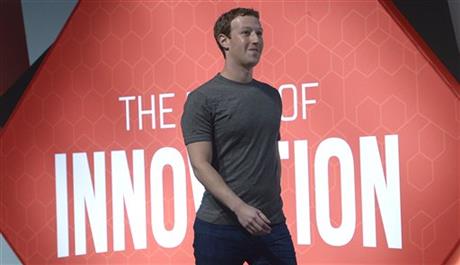
By JOSEPH WILSON
Sci-fi solutions or making friends one at a time? Google and Facebook are taking different routes to expanding Internet use and access among the unconnected in developing countries.
The two Internet giants gave updates on their efforts— and differing approaches— at the Mobile World Congress wireless show in Barcelona on Monday.
And while Facebook CEO Mark Zuckerberg and Google Vice President Sundar Pichai said they would like to collaborate more, they both appear happy to continue on their own way.
Zuckerberg said that in the past year, Internet.org, Facebook’s fledgling effort to create new users in countries with little or low Internet use, has launched its application with basic free services in six countries.
Zuckerberg said the initial feedback from telecom partners in those countries was positive, calling the app an “onramp” for paid services.
“Last year when we talked, I basically said we wanted to go in this direction,” Zuckerberg said. “It was my request to the industry to find partners who would work on this with us. Since then we have worked on this program and we have launched in six countries — four in Africa and Colombia and just a couple of weeks ago in India.
“Even if they have never used Internet in their life, they have basic services they can use— communication, health, education and jobs— and that basically serves as an onramp so people can learn why they would want to pay for data. And we are finding that is growing paid subscribers and overall subscribers of the Internet.”
The app is customized for each country and telecom operator so as to lure in new users while not hurting the telecoms’ already existing base of customers with free versions of services they already pay for. That is the reason why Internet.org does not include the WhatsApp messaging services, bought by Facebook last year.
Mario Zanotti, Senior Vice President of Operations at Millicom, said that Internet.org was working well for his company’s business in Paraguay.
“Internet is an abstract concept. We need to bring it down to earth,” he said.
Earlier, Pichai announced Google’s plans to start testing the use of solar-powered drone aircraft as “floating cell towers” that could bring coverage to remote areas or even disaster zones.
He also said that Google’s “Project Loon” to use high-altitude air balloons to provide coverage for rural areas had advanced to the point that they are expected to be ready in two years time.
“The model is really beginning to work, so we have started large-scale testing,” he said. “You can imagine a constellation of balloons and planes together, which we can stitch together to create a mesh of floating cell towers. That’s what we trying to do.
“We will be flying these planes out in the coming few months. That’s the next big step for us.”
While both executives said they would be willing to work more together— Internet.org, for example, includes Google Search— they also made sure to underscore their differences.
“No one company can bring connectability at scale for 4 billion people, and we are happy to work with them to provide our services on Internet.org, so that’s exciting for me,” Pichai said. “Having said that, it’s complementary, but what we are trying to do is different. We are trying to provide the actual backbone, the physical connectability at scale across the globe, so it is different.”
Facebook is also experimenting with drones and satellites, but Zuckerberg said that the focus on high-tech fixes was “sexy” though not as important as helping local telecom operators grow their businesses.



